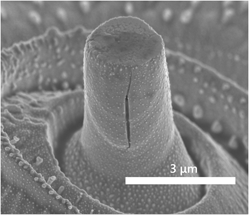Crossref Citations
This article has been cited by the following publications. This list is generated based on data provided by
Crossref.
Shin, Chansun
Jin, Hyung‐Ha
Kim, Weon‐Ju
Park, Ji‐Yeon
and
Green, D. J.
2012.
Mechanical Properties and Deformation of Cubic Silicon Carbide Micropillars in Compression at Room Temperature.
Journal of the American Ceramic Society,
Vol. 95,
Issue. 9,
p.
2944.
Korte, Sandra
and
Clegg, William J.
2012.
Studying Plasticity in Hard and Soft Nb–Co Intermetallics.
Advanced Engineering Materials,
Vol. 14,
Issue. 11,
p.
991.
Lacroix, R.
Kermouche, G.
Teisseire, J.
and
Barthel, E.
2012.
Plastic deformation and residual stresses in amorphous silica pillars under uniaxial loading.
Acta Materialia,
Vol. 60,
Issue. 15,
p.
5555.
Wheeler, J.M.
Niederberger, C.
Tessarek, C.
Christiansen, S.
and
Michler, J.
2013.
Extraction of plasticity parameters of GaN with high temperature, in situ micro-compression.
International Journal of Plasticity,
Vol. 40,
Issue. ,
p.
140.
Wheeler, J. M.
and
Michler, J.
2013.
Elevated temperature, nano-mechanical testing in situ in the scanning electron microscope.
Review of Scientific Instruments,
Vol. 84,
Issue. 4,
Palacio, Manuel L.B.
and
Bhushan, Bharat
2013.
Depth-sensing indentation of nanomaterials and nanostructures.
Materials Characterization,
Vol. 78,
Issue. ,
p.
1.
Shin, Chansun
Lim, Sangyeob
Jin, Hyung-ha
Hosemann, Peter
and
Kwon, Junhyun
2014.
Development and testing of microcompression for post irradiation characterization of ODS steels.
Journal of Nuclear Materials,
Vol. 444,
Issue. 1-3,
p.
43.
Amodeo, J.
Devincre, B.
Carrez, Ph.
and
Cordier, P.
2014.
Dislocation reactions, plastic anisotropy and forest strengthening in MgO at high temperature.
Mechanics of Materials,
Vol. 71,
Issue. ,
p.
62.
Schwiedrzik, Jakob
Raghavan, Rejin
Bürki, Alexander
LeNader, Victor
Wolfram, Uwe
Michler, Johann
and
Zysset, Philippe
2014.
In situ micropillar compression reveals superior strength and ductility but an absence of damage in lamellar bone.
Nature Materials,
Vol. 13,
Issue. 7,
p.
740.
Guo, J.J.
Madhav Reddy, K.
Hirata, A.
Fujita, T.
Gazonas, G.A.
McCauley, J.W.
and
Chen, M.W.
2015.
Sample size induced brittle-to-ductile transition of single-crystal aluminum nitride.
Acta Materialia,
Vol. 88,
Issue. ,
p.
252.
Armstrong, D.E.J.
Hardie, C.D.
Gibson, J.S.K.L.
Bushby, A.J.
Edmondson, P.D.
and
Roberts, S.G.
2015.
Small-scale characterisation of irradiated nuclear materials: Part II nanoindentation and micro-cantilever testing of ion irradiated nuclear materials.
Journal of Nuclear Materials,
Vol. 462,
Issue. ,
p.
374.
Žagar, Goran
Pejchal, Václav
Mueller, Martin G.
Rossoll, Andreas
Cantoni, Marco
and
Mortensen, Andreas
2015.
The local strength of microscopic alumina reinforcements.
Acta Materialia,
Vol. 100,
Issue. ,
p.
215.
Issa, I.
Amodeo, J.
Réthoré, J.
Joly-Pottuz, L.
Esnouf, C.
Morthomas, J.
Perez, M.
Chevalier, J.
and
Masenelli-Varlot, K.
2015.
In situ investigation of MgO nanocube deformation at room temperature.
Acta Materialia,
Vol. 86,
Issue. ,
p.
295.
Armstrong, David E. J.
and
Tarleton, Edmund
2015.
Bend Testing of Silicon Microcantilevers from 21°C to 770°C.
JOM,
Vol. 67,
Issue. 12,
p.
2914.
Raghavan, Rejin
Elias, Jamil
Erni, Rolf
Parlinska, Magdalena
Philippe, Laetitia
and
Michler, Johann
2015.
Mechanical behavior of intragranular, nano-porous electrodeposited zinc oxide.
Thin Solid Films,
Vol. 578,
Issue. ,
p.
174.
Godet, Julien
El Nabi, Firas Abed
Brochard, Sandrine
and
Pizzagalli, Laurent
2015.
Surface effects on the mechanical behavior of silicon nanowires: Consequence on the brittle to ductile transition at low scale and low temperature.
physica status solidi (a),
Vol. 212,
Issue. 8,
p.
1643.
Kelling, Andreas
Mangipudi, Kodanda Ram
Knorr, Inga
Liese, Tobias
Krebs, Hans-Ulrich
and
Volkert, Cynthia A.
2016.
Investigating fracture of nanoscale metal–ceramic multilayers in the transmission electron microscope.
Scripta Materialia,
Vol. 115,
Issue. ,
p.
42.
Sarobol, Pylin
Chandross, Michael
Carroll, Jay D.
Mook, William M.
Bufford, Daniel C.
Boyce, Brad L.
Hattar, Khalid
Kotula, Paul G.
and
Hall, Aaron C.
2016.
Room Temperature Deformation Mechanisms of Alumina Particles Observed from In Situ Micro-compression and Atomistic Simulations.
Journal of Thermal Spray Technology,
Vol. 25,
Issue. 1-2,
p.
82.
Schwiedrzik, Jakob
Raghavan, Rejin
Rüggeberg, Markus
Hansen, Silla
Wehrs, Juri
Adusumalli, Ramesh B.
Zimmermann, Tanja
and
Michler, Johann
2016.
Identification of polymer matrix yield stress in the wood cell wall based on micropillar compression and micromechanical modelling.
Philosophical Magazine,
Vol. 96,
Issue. 32-34,
p.
3461.
Camposilvan, Erik
and
Anglada, Marc
2016.
Size and plasticity effects in zirconia micropillars compression.
Acta Materialia,
Vol. 103,
Issue. ,
p.
882.
